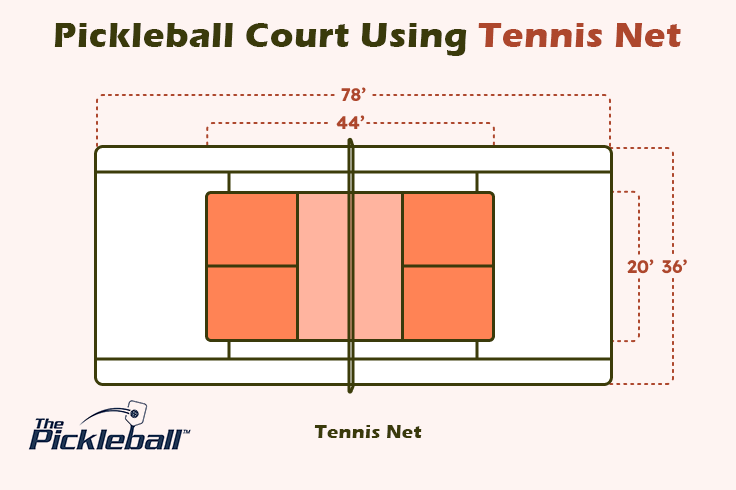

Have you been looking for a pickleball court in your area but have yet to find a bunch of tennis courts? Many avid players are experiencing the same issue!
As one of the fastest-growing sports, many communities and sports complexes find it challenging to accommodate the surging demand for pickleball.
Don’t worry. In this post, we will show you how to convert a tennis court into a pickleball court so you can play in more places.
Can You Play Pickleball on a Tennis Court?
The quick answer is: Yes, you can play pickleball on a tennis court.
Tennis has been around a lot longer than pickleball, so there are thousands of courts across the USA alone. The Tennis Industry Association estimates there are over 270,000 tennis courts nationwide. That means that tons of courts could be turned into a pickleball court.
You’ll occasionally see courts with pickleball lines; sometimes, they’re also different colors. If they don’t, you’ll need to convert it.
Understanding the Differences Between Tennis and Pickleball Courts
Pickleball may appear like tennis; however, there are particular distinctions between a regulation pickleball court and an ordinary tennis court. The main differences are the size of the court itself, the net height, and the lines.
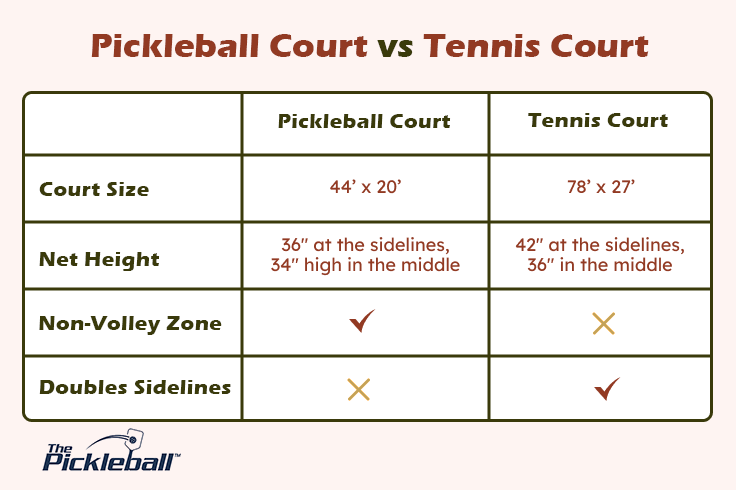
1: The Size Factor
A standard tennis court, measuring 78 feet by 36 feet, is much larger than a pickleball court’s official size of 44 feet by 20 feet, as endorsed by the USA Pickleball Association. This size difference means one tennis court can accommodate up to four pickleball courts. This space efficiency is turning many underutilized tennis venues into bustling pickleball hubs for local enthusiasts.
2: Differences in Net Height
The net height is a key distinction between tennis and pickleball. While portable pickleball nets are about 3.5 feet tall in the center and rise to approximately 3.6 inches higher at the ends according to USAPA guidelines, tennis nets stand consistently 3 feet 6 inches at the posts and drop to 3 feet in the center.
- Pickleball Net Height: Around 3.5 feet in the center, rising to about 3.6 inches higher at the ends, per USAPA guidelines.
- Tennis Net Height: 3 feet 6 inches at the posts and 3 feet in the center.
3: Pickleball Lines vs. Tennis Court Lines
Understanding the differences in court layout and markings is crucial when transitioning from tennis to pickleball or vice versa. Both sports, while sharing similarities, have their unique court lines:
- Tennis Court Lines:
- Service boxes are divided by center service lines.
- Baseline and sideline boundaries vary for singles and doubles matches.
- Pickleball Court Lines:
- Outer boundary markers.
- Specific demarcations for ‘non-volley zones’ where players can’t hit without the ball bouncing.
Reminder: Before adding lines to any public or private courts, ensure you have the necessary permissions. Unauthorized marking can be against the rules and may have legal consequences.
How to Play Pickleball on a Tennis Court
Distinguishing Between Pickleball and Tennis Court Lines
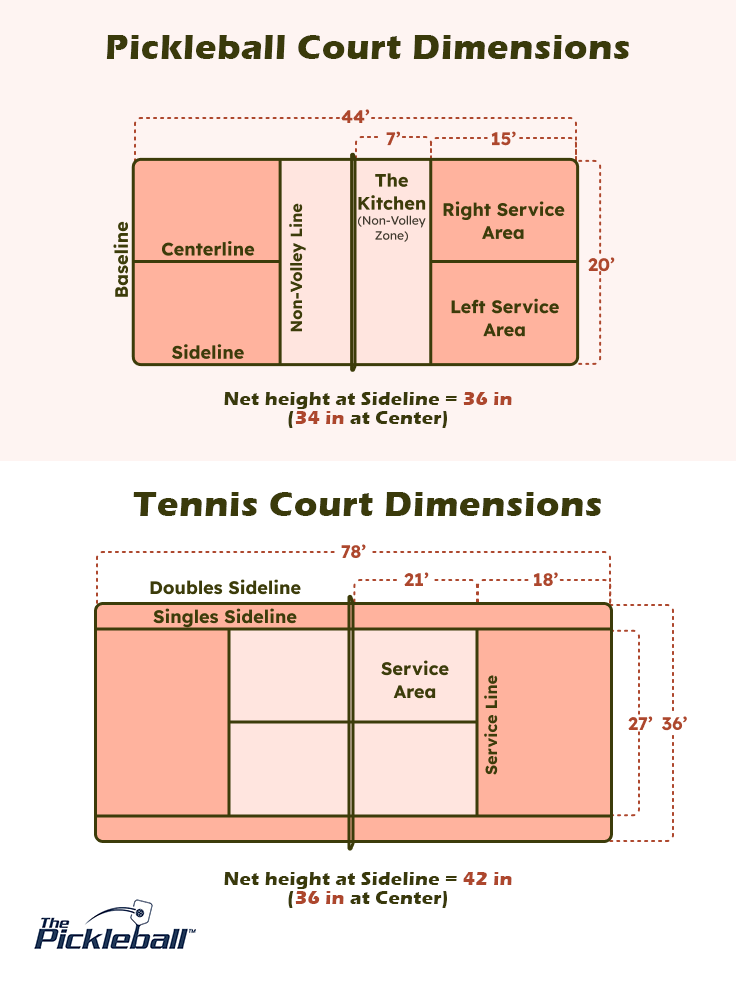

When setting up a pickleball court, it’s essential to understand the four primary sets of pickleball court lines:
- The Sidelines: These lines define the width of the pickleball court. They run perpendicular to the net, marking the left and right outer boundaries. While tennis courts also have sidelines, their width differs from pickleball courts.
- The Service Lines (or Baselines): Situated at the far ends of the court parallel to the net, these lines determine where players serve. They’re similar in concept to tennis baselines, but the court length in pickleball is shorter.
- The Center Lines: These lines split the court into left and right service boxes. Running from the baseline to the kitchen line, they help players determine their serving and receiving positions, especially in doubles play.
- The Kitchen Line (or Non-Volley Zone Line): This line is what sets pickleball apart. Positioned 7 feet from the net on both sides, it creates a zone where players can’t volley the ball (hit before it bounces). This strategic area, known as “the kitchen,” is unique to the game of pickleball.
While many lines in pickleball have counterparts in tennis, the kitchen line is exclusive to pickleball, adding a distinct strategic layer to the game. Understanding these lines is crucial for anyone looking to transition between the two sports or set up their own pickleball court.
Is a Tennis Net Suitable for Pickleball?
It depends; the suitability hinges on two primary factors: whether the net is adjustable and if you’re playing informally where a slight height difference isn’t a concern.


- Dimensions for a Tennis court net: 42 inches high at the posts and 36 inches at the center.
- Dimensions for a Pickleball court net: 36 inches at the posts and 34 inches at the center.
With pickleball’s skyrocketing popularity, adjustable tennis nets are becoming more prevalent. However, tennis net adjusters are available for purchase; these allow players to modify a tennis net to fit pickleball height standards. However, many pickleball enthusiasts still prefer their own portable pickleball nets.
It’s best to play pickleball with a net of the appropriate height. Yet, a tennis net works just fine if you’re engaging in a relaxed pickleball game and the height difference doesn’t concern you. Always prioritize what’s most fun for you and your friends!
Maximizing Space with Multiple Pickleball Courts
When playing pickleball on a tennis court, you can set up two pickleball courts on each side, optimizing the available space.
Understanding the spatial arrangement is crucial when transforming a tennis court for your pickleball game. Depending on your needs, you can opt for a single-court setup or maximize the space with multiple courts. Here’s a breakdown:
Single vs. Multiple Courts: How Many Pickleball Courts Fit on a Tennis Court
- Single Court Setup: One pickleball court can easily fit within the boundaries of a tennis court, using the tennis court’s existing boundaries with minor adjustments primarily for the non-volley zone or ‘kitchen.’
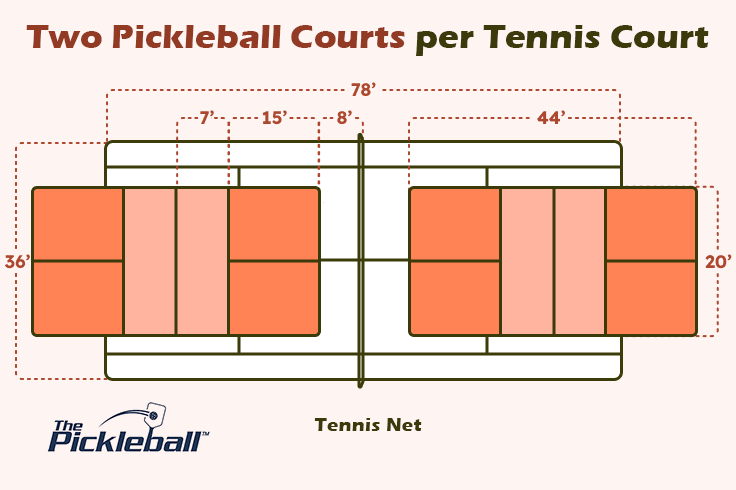

- Multiple Court Setup: Depending on the size and orientation of the tennis court, up to four pickleball courts can be set up side by side, maximizing the use of space and allowing multiple games to be played concurrently.
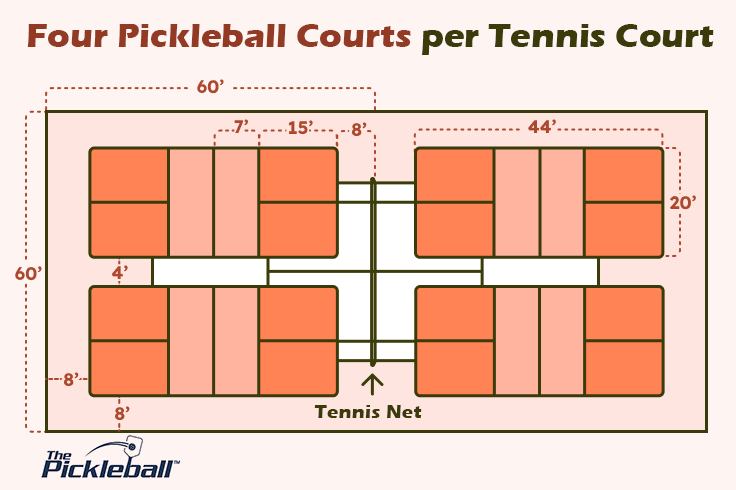

Remember the golden rule: space is your friend when laying out multiple pickleball courts on a tennis court. Always leave about 10 feet between each court. It’s not just about maximizing the number of courts; it’s about ensuring everyone has room to move freely without crossing into another game. Trust me, that little buffer makes all the difference in keeping games smooth and players safe.
Additional Tips for Setting Up Multiple Pickleball Courts on a Tennis Court
When you’re setting up multiple pickleball courts within the confines of a tennis court, there are nuances to keep in mind to ensure seamless gameplay:
- Equipment Organization: With several games unfolding simultaneously, it’s crucial to have a system for keeping gear organized. Designate specific areas for pickleball racquets, balls, and personal items. Consider using color-coded bins or bags for each court. Not only does this prevent mix-ups, but it also ensures players save time searching for their equipment. Click here to see a paddle rack we recommend.
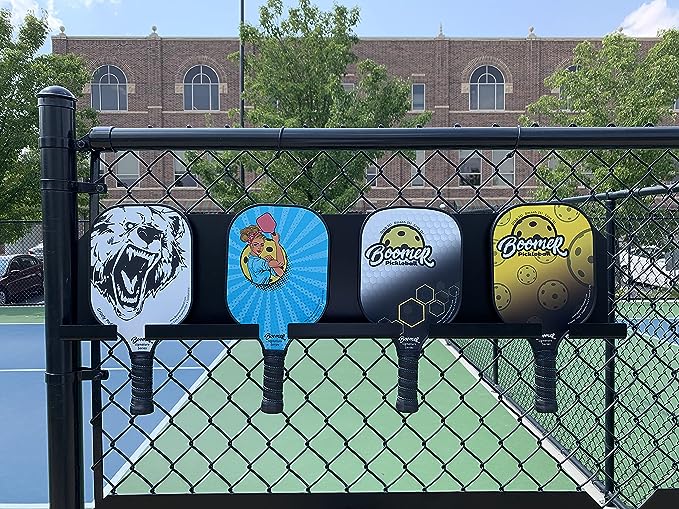

- Facilitating Smooth Transitions: As players finish, take breaks, or rotate between games, it’s vital to have a system that allows for fluid transitions. Clear pathways should be established so players can enter and exit courts without disrupting ongoing matches. Also, consider setting up a ‘waiting zone’ near each court where the next set of players can prepare and jump in as soon as the previous game concludes. Check out some of the apps we suggest to keep things smooth.
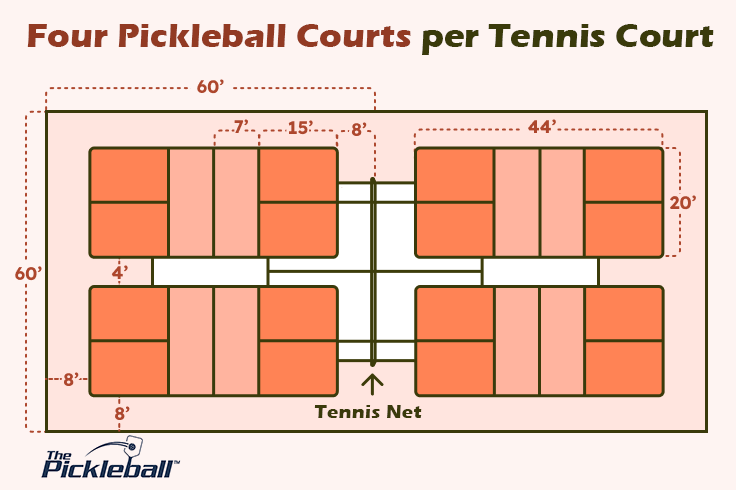

- Locating the Ideal Starting Point: When setting up a pickleball court within the boundaries of a tennis court, pinpointing the right starting point is paramount. Begin by finding the center of the tennis court. You can work outward from there, ensuring your pickleball court perfectly aligns with the larger space. This central starting point provides symmetry, allowing you to utilize the maximum space available and fit in additional courts. It also ensures equal room on each side, reducing players’ risk of entering adjacent courts or barriers. Using measuring tape and some temporary markers can be invaluable in achieving proper alignments.
How Much Does it Cost to Convert a Tennis Court to a Pickleball Court?
There are numerous ways to convert a tennis court into a pickleball haven, ranging from a complete overhaul to simpler, cost-effective adjustments.
A complete conversion from a tennis court to a pickleball court
Converting a full tennis court to a pickleball court ranges anywhere from $25 to upwards of $1000+ depending on what you choose to do.
Here’s a breakdown of the potential costs involved in such a project:
- Court Surface Preparation: To ensure a seamless conversion, repairing any existing damages to the tennis court might be necessary. A well-maintained surface not only enhances the playing experience but also provides the longevity of the court.
- Pickleball Court Lines: Proper and clear marking is essential. Whether you’re looking at temporary tape or permanent paint, the correct lining is crucial for accurate gameplay. Of course, the permenant option is the most expensive.
- Net Post Adjustments: The height specifications for tennis and pickleball nets differ. Adjustments or replacements might be needed to fit pickleball standards depending on your existing tennis court setup. There are portable nets you can use or tennis net adjusters that will adjust the height.
- Additional Amenities: As you transition, consider adding pickleball-centric amenities. These could range from setting up seating areas to improving fencing or installing specialized lighting for nighttime play.
- Labor Costs: Labor expenses can fluctuate based on your geographical location and the complexity of the tasks. It’s a primary factor in the overall conversion cost.
- Pickleballs & Paddles: You’ll want to have approved pickleballs and paddles instead of tennis racquets and tennis balls. These range from $15 to hundreds of dollars.
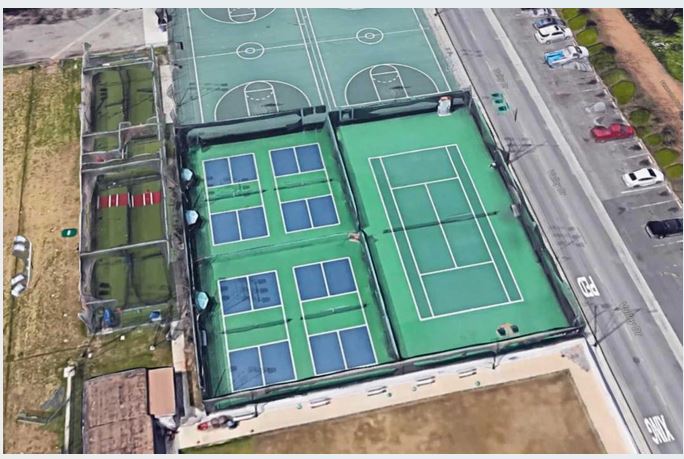

Budget-friendly Conversion: Temporary Lines and Net Adjustments
For those looking for a more economical approach, there are more straightforward ways to transition your tennis court for pickleball play:
- Applying Temporary Pickleball Court Lines: Instead of permanent markings, use removable tape or chalk to create pickleball court boundaries.
- Pickleball Net Purchase or Net Adjusters: You have a couple of options regarding the net. You can buy a dedicated pickleball net, or if you want to use your existing tennis net, consider getting a net adjuster.
Players can enjoy pickleball without committing to a complete court transformation by opting for these adjustments.
Drawing Temporary vs. Painting Permanent Court Lines
When considering the transformation of a tennis court for pickleball, one of the primary considerations is how to mark the court. Both temporary and permanent options have advantages, and the best choice depends on your needs, commitment, and budget.
- Drawing Temporary Lines: Opting for temporary lines offers flexibility and is ideal for those who want to revert back to a tennis court or avoid a permanent commitment. They can easily be applied using tape or chalk and removed without leaving any lasting trace.
- Painting Permanent Lines: Having permanent pickleball lines professionally painted is a durable solution, with costs typically ranging from $250 to $600, depending on various factors. While a DIY approach might be tempting, it’s not typically recommended; errors can be challenging to correct and may lead to additional expenses.
In summary, while temporary lines offer a flexible and cost-effective solution, painting permanent lines provides enhanced durability and consistency for gameplay. Both options cater to different needs and preferences in the pickleball community. Regardless of the method chosen, always remember to obtain the necessary permissions from the court owner before adding lines to public or private tennis courts to avoid any potential legal issues or penalties.
Setting Up a Pickleball Net on a Tennis Court
Pickleball nets are readily available for purchase online, catering to the sport’s growing popularity. You’ll typically find a range in price from $50 to $4000, depending on the brand and features. The best part? Most nets are designed for quick and easy setup.
Steps to Set Up a Pickleball Net:
- Choose the Location: Find a flat and even space on the tennis court where you want to place the net.
- Unpack and Layout: Remove the net from its carrying case and lay it flat.
- Assemble the Frame: Connect the poles and support structures as instructed by the manufacturer.
- Attach the Net: Hang the net over the frame, ensuring it’s evenly distributed and properly tensioned.
- Check the Height: Ensure that the net’s height is correct – 36 inches at the side posts and 34 inches in the center.
- Secure the Setup: Use the provided weights or stakes to anchor the net, ensuring it remains stable during play.
The Quickest Way to Convert a Tennis Court to a Pickleball Court
So, you’re looking to quickly turn that tennis court into a pickleball court? We’ve got you covered. Here’s a straightforward guide to get you playing in no time.
Equipment Needed for a Quick Tennis Court Conversion:
- Tape or Chalk: Temporary pickleball lines are often made using brightly colored tapes or chalks that can be easily laid down and removed.
- Pickleball Net (or Net Adjuster): If you’ve got a tennis net, an adjuster can help you bring it down to pickleball height. But having a dedicated pickleball net is even better.
- Pickleball Paddles & Balls: Pretty obvious, but make sure everyone’s got one!
- Measuring Tape: To ensure that lines and net height are just right.
- These are often brightly colored tapes or chalks that can be easily laid down and removed.
Steps to Convert:
- Clean the Court: Start with a clean slate by ensuring the court is debris-free.
- Measure and Mark: Use the measuring tape to map out the pickleball court dimensions.
- Lay Down the Temporary Lines: Whether you’re using tape or chalk, carefully mark the boundaries, ensuring they’re visible.
- Set Up the Net: If you have a pickleball net, set it up per its instructions. If adjusting a tennis net, use the adjuster to bring it to the right height.
- Final Check: Walk around the court and ensure everything looks right. You could even play a test point or two!
And there you have it! With just a little effort, your tennis court is now ready for some intense pickleball action. Remember, it’s all about having fun and enjoying the game. So, gather your friends and serve up some good times!
Tips for Maintaining a Pickleball Court
Taking care of your pickleball court ensures its longevity and playability. Here are some quick and essential maintenance tips:
- Regular Cleaning: Use a court broom or blower to remove debris like leaves and dirt. This keeps the surface safe and smooth.
- Surface Inspection: Periodically, with the help of a flat-edge tool, check for cracks or uneven surfaces. Address issues quickly to avoid worsening.
- Net Care: Ensure the net is taut and free from tears. When it shows wear, consider a replacement.
- Line Integrity: A chalk liner or tape can help touch up faded or peeling court lines. Keep them visible and intact.
- Drainage: To prevent water accumulation, ensure surrounding areas have good drainage. Pooled water can damage the surface.
Remember, consistent care keeps your court in top shape for many matches to come!
Accessories For Your Pickleball Court
Setting up a pickleball court is just the beginning; accessorizing it can take your game to the next level. Here are some of the handiest tools and gadgets that every pickleball enthusiast might consider:
- Outdoor Court Tape: Helps lay down temporary boundaries without leaving a residue.
- Pickleball Tutor: A training aid for solo play or enhancing specific shots.
- Court Line Chalk: Ideal for quick, temporary court markings.
- Lobster Pickleball Machine: An advanced way to practice with varied ball delivery.
- Ball Holder: Keeps your pickleballs organized and within reach.
- Ball Pickup Tool & Ball Tube: Say goodbye to the back-bending routine after a game. Makes collecting balls a breeze.
- Caddy: A multifunctional tool to keep all your pickleball gear organized.
- Ballsize Pickleball Holder: Specialized storage for your pickleballs.
- EZ Court Lines: Vinyl strips that easily lay out the basics of the court; two sets give you a full court.
- Pickleball Court Stencil: Makes drawing permanent or semi-permanent lines simpler.
- Multi Paddle Holder: A neat solution to store multiple paddles.
- Ball Holder Belt: For players who prefer having balls at their waist during practice.
- Score Taker: Keep track of scores without a fuss.
- Rebounder Net: Perfect for solo practices to enhance reflexes.
- Tennis Net Adjuster: Modify your tennis net height for pickleball in no time.
- Popup Targets: Helps sharpen your aiming skills during practice.
- Practice Cones: Great for skill drills and agility training.
Accessorizing your pickleball court is like giving it a personal touch and setting it up for efficient and enjoyable play. From practice to game day, these accessories ensure you’re ready for every serve and volley. Happy playing!
FAQs
Can you play pickleball on a regular tennis court?
Yes, with some modifications to the lines and adjusting the net height, you can play pickleball on a regular tennis court.
Can you play pickleball on a short tennis court?
Absolutely. The dimensions of a short tennis court are closer to those of a standard pickleball court, making it an ideal conversion candidate.
Can you play pickleball on a clay tennis court?
You can, but it may affect ball bounce and player movement due to the softer surface compared to the hard courts typically used for pickleball.
Do I need to check local regulations before converting a tennis court to a pickleball court?
Obtaining permits and adhering to legal requirements is an essential step in the conversion process. It is important to check with local authorities to determine what permits are necessary and how to obtain them. If you live in a neighborhood with an HOA, you may want to check with them as well. If the tennis court is a private court, you’ll definitley want to check with the owners first.
Are tennis shoes the same as pickleball shoes?
No. While they may have a similar design, there are specific features like lateral support and sole tread patterns that differ between shoes designed for each sport.
Can You Use a Tennis Racket Instead of a Pickleball Paddle?
No. it’s not advised. While pickleball and tennis fall under the umbrella of racket sports, their equipment is notably distinct. Using the correct gear for each game is essential to ensure fair play and optimal performance. Now, let’s delve into the primary differences between a pickleball paddle and a tennis racket:
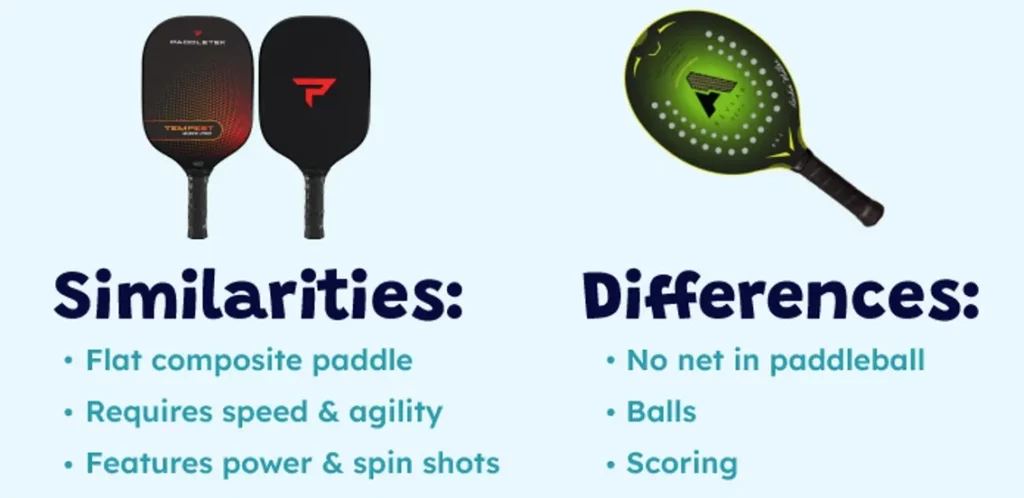

- Material:
- Pickleball Paddle: Typically made from composite materials such as graphite, carbon fiber, or aluminum. Some might also be made from wood, especially the cheaper options.
- Tennis Racket: Predominantly made from graphite, but can also include materials like carbon fiber, aluminum, and sometimes even wood.
- Size and Shape:
- Pickleball Paddle: More compact, almost resembles a larger table tennis paddle. There’s no differentiated handle, almost uniformly rectangular or slightly oval.
- Tennis Racket: Larger with a distinctly separate handle and a long neck leading to an oval hitting area strung with strings.
- Weight:
- Pickleball Paddle: Generally lighter, often ranging from 6 to 14 ounces.
- Tennis Racket: Typically heavier, with weights ranging from 9 to 12 ounces (before strings), and can go up to 14 ounces when strung.
- Surface:
- Pickleball Paddle: Solid with no strings, might have a textured surface to influence ball spin.
- Tennis Racket: Strung with synthetic or natural gut strings, which play a significant role in ball control, spin, and power.
- Grip:
- Pickleball Paddle: Shorter grip, ideal for wrist movements and close-to-net plays.
- Tennis Racket: Longer grip tailored for both one-handed and two-handed shots, providing more reach and leverage.
- Purpose and Play Style:
- Pickleball Paddle: Designed for a game that emphasizes placement, strategy, and quick reflexes, often with a softer ball.
- Tennis Racket: Built for a game involving powerful serves and groundstrokes, topspins, slices, and volleys, played with a bouncy rubber ball.
In essence, while the pickleball paddle and the tennis racket serve the fundamental purpose of striking a ball, their design and features are tailored to their respective sports’ unique requirements and nuances.
Summary
As the enthusiasm for pickleball continues to soar, it’s evident that this sport isn’t just a fleeting trend—it’s a movement. By understanding how to adeptly convert a tennis court, a world of possibilities unlocks, presenting countless venues to indulge in this fast-paced game. Whether going the full mile with permanent modifications or simply opting for temporary setups, there’s an option for every level of commitment. Armed with knowledge of accessories, maintenance, and the nuances between pickleball and tennis equipment, you’re set to maximize your experience on the court. So, embrace the growth, find local pickleball courts in your area, enjoy the vibrant pickleball community, and most importantly, have an absolute blast with one of the most exciting racquet sports. Happy playing!






